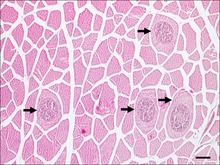| Olive flounder | |
|---|---|

| |
| In a supermarket display tank | |

| |
| Drawing by Kawahara Keiga | |
| Scientific classification | |
| Domain: | Eukaryota |
| Kingdom: | Animalia |
| Phylum: | Chordata |
| Class: | Actinopterygii |
| Order: | Carangiformes |
| Suborder: | Pleuronectoidei |
| Family: | Paralichthyidae |
| Genus: | Paralichthys |
| Species: | P. olivaceus |
| Binomial name | |
| Paralichthys olivaceus (Temminck & Schlegel, 1846) | |
| Synonyms | |
|
Hippoglossus olivaceus Temminck & Schlegel, 1846 | |
The olive flounder (Paralichthys olivaceus), bastard halibut or Korean halibut is a temperate marine species of large-tooth flounder native to the North-western Pacific Ocean. It is the highest valued finfish in the world, known to be excellent for aquaculture due to a rapid growth rate and popularity in Korea.
Names
In Korean, olive flounder is known as gwangeo (광어). In Japanese, it is called hirame (ヒラメ). In Chinese, it is called yaping (牙鮃) or biankouyu (扁口魚).
In English, it is often referred to as "Korean flatfish" or "Japanese flatfish" when mentioned in the context of those countries.
Description
It reaches a length of 103 cm (41 in) and a weight of 9.1 kg (20 lb). In 2017 its genome and transcriptome was sequenced as a model to study flatfish asymmetry.
-
 Specimen at Joetsu Aquarium
Specimen at Joetsu Aquarium
-
 Closeup of eyes
Closeup of eyes
Habitat and diet
The olive flounder is often found in soft and muddy offshore, coastal areas where the water level goes down to 100 m in depth. The temperature of water in these areas range from 21–24 °C or 69–75 °F. Some flounder have been found in the Mariana Trench.
Olive flounder typically eat fish spawn, crustaceans, polychaetes, and small fish.
Life cycle
Olive flounder spawn anytime from January through August in shallow water, roughly about 70 cm in depth. The egg and larvae remain that way for about 24–50 days after hatching. Once they begin their metamorphosis process, they move towards more sandy areas and feed on shrimp. After achieving metamorphosis, the flounder move offshore and begin feeding on bigger fish in order to grow to their adult size.
How they become "flatfish"
Olive flounder first start out upright like normal fish, but then after 24 to 50 days after hatching they turn onto their side. Their previous side now becomes their belly or their backside and then their eye and nostril move towards what is now considered the back. This process is typically called the "metamorphosis."
Aquaculture

The olive flounder is the most common flatfish species raised in aquaculture in Korea. They are raised in Japan and China as well. It is the most highly prized of the Japanese flounders. Although the aquaculture for the olive flounder started from the late 1980s, its commercial production didn't begin on a major scale until the 1990s in Korea.
Parasites and food poisoning

The myxozoan Kudoa septemlineata has been described in 2010 from olive flounder from Korea. This microscopic parasite infects the trunk muscles of the olive flounder where it causes myoliquefaction. Ingestion of raw fish containing K. septemlineata spores has been reported as a cause of food poisoning (gastroenteritis) in Japan since 2003. However, laboratory studies performed in 2015 and 2016 on adult and suckling mice showed that K. septemlineata spores were excreted in faeces and did not affect the gastrointestinal tract.
As food
Oliver flounder is widely eaten as food in East Asia, often raw.
Appearances in media
The olive flounder has appeared in the video game series Animal Crossing as one of the various fish species the player is able to catch using a fishing rod.
References
- ^ Bai, Sungchul C.; Lee, Seunghyung (2010-04-19). "Culture of Olive Flounder: Korean Perspective". In Daniels, H. V.; Watanabe, W. O. (eds.). Practical Flatfish Culture and Stock Enhancement. Wiley-Blackwell. pp. 156–168. doi:10.1002/9780813810997.ch9. ISBN 978-0-8138-1099-7.
- Froese, Rainer; Pauly, Daniel (eds.). "Paralichthys olivaceus". FishBase. May 2014 version.
- Shao, Changwei; Bao, Baolong; Xie, Zhiyuan; Chen, Xinye; Li, Bo; Jia, Xiaodong; Yao, Qiulin; Ortí, Guillermo; Li, Wenhui (January 2017). "The genome and transcriptome of Japanese flounder provide insights into flatfish asymmetry". Nature Genetics. 49 (1): 119–124. doi:10.1038/ng.3732. hdl:10400.1/11355. ISSN 1061-4036. PMID 27918537.
- "Fisheries and Aquaculture - Global Production". Food and Agriculture Organization of the United Nations (FAO). Retrieved 2024-05-06.
- Matsukane, Yuuki; Sato, Hiroshi; Tanaka, Shuhei; Kamata, Yoichi; Sugita-Konishi, Yoshiko (2010). "Kudoa septempunctata n. sp. (Myxosporea: Multivalvulida) from an aquacultured olive flounder (Paralichthys olivaceus) imported from Korea". Parasitology Research. 107 (4): 865–872. doi:10.1007/s00436-010-1941-8. ISSN 0932-0113. PMID 20549238.
- Kawai, T.; Sekizuka, T.; Yahata, Y.; Kuroda, M.; Kumeda, Y.; Iijima, Y.; Kamata, Y.; Sugita-Konishi, Y.; Ohnishi, T. (2012). "Identification of Kudoa septempunctata as the Causative Agent of Novel Food Poisoning Outbreaks in Japan by Consumption of Paralichthys olivaceus in Raw Fish". Clinical Infectious Diseases. 54 (8): 1046–1052. doi:10.1093/cid/cir1040. ISSN 1058-4838. PMID 22281845.
- Iwashita, Yoshiaki; Kamijo, Yoshito; Nakahashi, Susumu; Shindo, Akihiro; Yokoyama, Kazuto; Yamamoto, Akitaka; Omori, Yukinari; Ishikura, Ken; Fujioka, Masaki; Hatada, Tsuyoshi; Takeda, Taichi; Maruyama, Kazuo; Imai, Hiroshi (2013). "Food Poisoning Associated with Kudoa Septempunctata". The Journal of Emergency Medicine. 44 (5): 943–945. doi:10.1016/j.jemermed.2012.11.026. ISSN 0736-4679. PMID 23357380.
- Ahn, Meejung; Woo, Hochoon; Kang, Bongjo; Jang, Yeounghwan; Shin, Taekyun (2015). "Effect of oral administration of Kudoa septempunctata genotype ST3 in adult BALB/c mice". Parasite. 22: 35. doi:10.1051/parasite/2015035. ISSN 1776-1042. PMC 4668110. PMID 26630307. [REDACTED]
- Jang, Yeounghwan; Ahn, Meejung; Bang, Hyojin; Kang, Bongjo (2016). "Effects of Kudoa septempunctata genotype ST3 isolate from Korea on ddY suckling mice". Parasite. 23: 18. doi:10.1051/parasite/2016020. ISSN 1776-1042. PMC 4828580. PMID 27067108. [REDACTED]
- "Animal Crossing: New Horizons Fish Guide - How To Catch, Prices, Shadow Sizes, And More". GameSpot. Retrieved April 16, 2020.
| Taxon identifiers | |
|---|---|
| Paralichthys olivaceus | |




